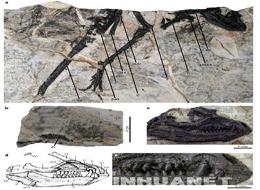
Fossils of Tianyulong Confuciusi
Dinosaur fossils recently discovered in northeast China's Liaoning province have bewildered scientists about the evolutionary development of feathers.
The sub-adult Tianyulong Confuciusi, which was covered with feather-like structures, dates back to the early Cretacious Period(144-99 million years ago), when the first dinosaurs emerged - long before anything like feathers had been believed to have started developing.
And the find, described in the journal Nature, presents another stumper: "This order of dinosaur was never supposed to have had anything like feathers," Chinese Academy of Geological Sciences paleontologist You Hailu was quoted by Thursday's China Daily as saying.
Tianyulong belonged to the Ornithischia, or "bird-hipped" order, which had been believed to have never developed any feather-like structures - that is, until Tianyulong was discovered with three patches of skin covered with "proto-feathers", more commonly known as "dino-fuzz".
The Ornithischia order also included lumbering armored sauropods, such as Triceratops and Stegosaurus.
It was theropods among the "lizard-hipped" Saurischia order that are known to have developed feathers and evolved into birds.
"Tianyulong is the first Ornithischian to have feather-like structures all over its body," You said.
"In addition, it belongs to the heterodontosaurids, the most evolutionarily basal branch of the entire great radiation of herbivorous dinosaurs, the Ornithischia."
Tianyulong had a gracile body, estimated to be 70 cm long, a 6-cm-long cranium and a 44-cm-long tail.
Ohio University professor Lawrence M. Witmer said Tianyulong's discovery has "made an already confusing picture of feathers' origins even fuzzier".
Feathers were believed to be an exclusively avian attribute, found in all birds today and extending back some 150 million years ago to the iconic Archaeopteryx of the Late Jurassic Period.
But the picture became muddled after the 1996 discovery of predatory theropods in Liaoning that were covered in avian-like feathers, forcing scientists to acknowledge feathered dinosaurs as modern birds' evolutionary ancestors.
Tianyulong's discovery suggests both the two orders of dinosaurs - Saurischia and Ornithischia - developed proto-feathers.
And because Tianyulong was among the most primitive of early dinosaurs, it stands to reason that "the origin of feathers might go right back to the origin of dinosaurs as a whole, more than 200million years ago", Witmer said.
You said: "In order to bring the evolutionary picture of feathers into sharper focus, scientists have to look back to the origin of dinosaurs, even beyond dinosaurs."
But other controversies surround the find.
Most scientists presume Tianyulong's dino-fuzz grew outside, rather than inside, its skin. But, Witmer said, although it is unlikely the structures were dermal (inside the skin), it cannot be known for sure they were epidermal (outside the skin).
"The difference between epidermal and dermal is huge," he said.
"If they are epidermal, then they bear not only on feather evolution and avian origins but also on metabolic physiology, behavioral display and flight.
"If they are dermal, then they're ultimately structural in function and have little bearing on those other issues."
You said further research using biochemical and molecular technologies will provide more assertive answers. But from what is known now, the filaments' attributes suggest they were epidermal. (From Xinhua)





